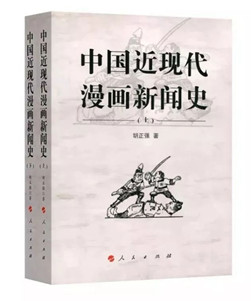
. > WHAT'S NEW > BOOKS
How modern Chinese news cartoons grew up
Author : PENG LEI Source : Chinese Social Sciences Today 2020-02-14

History of Modern Chinese News Cartoons
News cartoons report on the latest major political, economic and social issues in the form of illustrations, and thus they draw on both journalism and art. In History of Modern Chinese News Cartoons, Hu Zhengqiang, a professor from the School of Design Art and Media at Nanjing University of Science and Technology, focuses on the development trajectory of news cartoons in modern China from 1840 to 1949, their change in status from a subsidiary to an independent form, and their process of professionalization and normalization. Hu believes that major attention should be paid to the journalistic nature of modern news cartoons.
The Situation in the Far East by Tse Tsan-tai in 1898 was the first modern news cartoon in China. After the lift of strict bans relating to newspaper publishing and speech censorship in 1901, journalism entered a period of vigorous development. The rapidly rising newspaper and periodical industry created important opportunities for news cartoons. In September 1918, Shanghai Puck started China’s first special comic magazine. During the May 4th Movement in 1919, Chinese news cartoons ushered in a second round of booming development, which was also a crucial period for news cartoons’ modern transformation. During this period, news cartoons were a magic weapon for newspapers competing for readers, and furthermore they served as an important channel for expressing opinions on major current events.
In December 1926, the Manhua Society was established, China’s first cartoon organization. Then China’s news cartoons entered a new stage, as multiple organizations came into being. In November 1936, the first national comic exhibition in Chinese history was held in Shanghai. During the War of Resistance against Japan (1931–45) and the War of Liberation (1946–55), cartoonists picked up their pens as weapons in the battlefields of ideology and culture.
Editorials and reports are two different types of news, and they play the role of subjective comment and objective reporting respectively. In the face of the severe national crisis that ranged from 1840 to 1949, intellectuals urgently advocated nationwide enlightenment. In this context, news cartoons combined the functions of both editorials and reports, with a focus primarily on the former. During the Northern Expedition (1926–28), cartoonists served as a front in revolutionary publicity movements and promoted the publicity function of news cartoons to its full capability.
After late 1920s, news circles sought to establish an objective and neutral model of reporting. From 1927 to 1937, informative cartoons combined comics with news text, having a strong documentary nature. They were often printed in main news pages instead of in supplements, realizing the potential of news cartoons for reporting.
Peng Lei is a lecturer from the College of Humanity and Law at Huazhong Agricultural University.
Ye Shengtao made Chinese fairy tales from a wilderness
Ye Shengtao (1894–1988) created the first collection of fairy tales in the history of Chinese children’s literature...
-
How northern ethnicities integrated into Chinese nation
2023-09-18
-
Mogao caves
2023-09-12
-
Mogao Grottoes as ‘a place of pilgrimage’
2023-09-12
-
Time-honored architectural traditions in China
2023-08-29
-
Disentangling the civilizational evolution of China
2023-08-28
-
AI ethics in science fiction
2023-08-23













 2011-2013 by www.cssn.cn. All Rights Reserved
2011-2013 by www.cssn.cn. All Rights Reserved